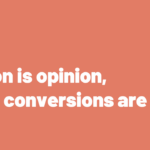Google Analytics has recently gone through significant changes that have sparked concerns among marketers around its bias and validity. As digital tracking continues to break, we need the right models and tools that will help us make the best decisions around budget allocation and, because of that, we need to question what the role of Google Analytics in a modern marketer’s stack should be.
In this article, we’ll explore how Google Analytics is letting marketers down, examine these recent changes, discuss their implications, and share with you the alternative solutions for marketers seeking more comprehensive and unbiased analytics and attribution.
Google Analytics Sunsets 4 Attribution Models – what that means to you:
In April 2023, Google announced the removal of four attribution models—first click, linear, time decay, and position-based—from both Google Ads and Google Analytics.
As explained by Google Ads’ liaison, here’s the rationale behind this decision:
“The use of rules-based attribution models has dropped significantly with the introduction of the data-driven attribution model 3 years ago. Fewer than 3% of conversion actions in Google Ads use them now. DDA has the broadest adoption & is available to all businesses, with no data requirements.”
If you’re wondering about the timeline of these changes, here’s a quick summary:
- Unavailability of the four models in GA4 starting May 2023
- Unavailability of the four models in Google Ads starting June 2023
- Complete sunset of the four models in September 2023
The removal of these attribution models has raised several concerns among data-driven marketers:
Firstly, their focus on the DDA brings up a lot of questions about its lack of transparency in how it’s calculated. If we can’t see the attribution formula, how can marketers fully understand how conversions are attributed across touchpoints?
The other big challenge of this change is that media buyers are losing insights that they value. The deprecated models provided information into different aspects of the customer journey – that is now lost or, at least, much more difficult to find.
For example, the first-click model could help marketers understand the effectiveness of their top-of-funnel campaigns, while the linear model equally distributed conversion credit across all touchpoints and gave a more balanced view of the customer journey. Were they perfect attribution methods? Absolutely not. But they did give a data point worth considering.
A couple of examples of media buyers showing how these changes will affect them:
Also, don’t miss this piece of very eloquent feedback:
Jokes aside, this comes at the heels of another announcement from Google Analytics that made the community continue to question GA’s accuracy and bias.
GA4 Now Can Import Conversions Outside of Google Ads… WIth a Catch
Following a recent update, Google Ads can now import fractional, cross-channel web conversion credits from Google Analytics 4 properties. This change is meant to bring more accurate measurement and enhanced optimization as, before this, web conversions were imported on a cross-channel last-click basis from Google Analytics 4 and attributed in Google Ads according to the selected attribution model. This approach failed to import any conversions if the final click did not originate from Google advertising.
With this update, fractional cross-channel conversion credit will be imported into Google Ads, even if the last non-direct click was not from Google Advertising. For example, if a conversion action is imported using data-driven attribution, all fractional, attributed Google credits will be imported into Google Ads, regardless of the ultimate touchpoint.
The catch – because of course there’s a catch – is that they must also use GA4. Here’s the full update:
And the question you see in the tweet is crucial:
Why Would You Ever Trust Google Analytics?
Google Analytics is, of course, a Google product. This creates misaligned incentives that can introduce biases and lead marketers into making suboptimal decisions. The changes we just covered continue this trend of distrust around Google Analytics, and for good reason.
If Google Analytics has a potentially inherent bias toward Google Ads, it could potentially be over-crediting Google Ads in its attribution models and skewing marketers’ perception of the effectiveness of their campaigns, making them appear more successful than they actually are.
Quick example: are you looking at your Google Analytics to see if your paid brand search is effective? Follow-up question: has a car salesman ever said that you don’t need a new car and to save your money instead? (If you’re now wondering if your brand search spend is incremental or not, we wrote an article on how to test it.)
We’re saying this tongue-in-cheek, but this is a real problem. A big part of Recast’s mission is to eliminate wasted spend – and potential bias within your attribution platforms can easily lead down that path.
If your Google Ads are over-credited, you invest more in them thinking they’re being incremental – and worse, you have the data to rationalize that decision, even though that data is skewed and you don’t know it. This will undermine your multi-channel marketing efforts and pay a big opportunity cost.
Alternative Attribution Solutions:
Most marketers already know that they should not be relying fully on Google Analytics. As Recast’s CEO said,
“There was never a time when it was great to use just GA, but there was a time when it mostly worked and now it just doesn’t mostly work anymore. It’s just too difficult to track people across the Internet. We can’t track people across different apps on iOS. The cookies are starting to go away and are less and less useful. So we’re just getting less and less signal about how we can track people across the Internet.”
There’s no perfect measurement method. Marketers need to accept that and really embrace it, and start to think about what are the different angles through which we can view our marketing performance.
Digital tracking is still one way. Surveys, post-checkout surveys, and polls are another way. Experimentation and lift tests, that’s another way. Statistical modeling, that’s another way. All of these different measurement methods need to be embraced for marketers to be successful going forward.
Recast was built to offer you another way: a modern approach to Marketing Mix Modeling. Since it doesn’t rely on digital tracking, it’s an attribution model that can be really effective in reducing bias and help you better allocate your budget with a focus on incrementality.
Conclusion:
Google Analytics’ recent changes have raised concerns among high-level marketers and brought back questions about how much bias is ingrained in the product and how that can make understanding customer journeys and allocating marketing budgets more challenging.This article isn’t meant to defame Google Analytics – they have a time and a place where they can be useful. But it is truly crucial that 1/ marketers think critically about biases and misaligned incentives, and 2/ that we all adopt multiple attribution solutions to get a more accurate picture of what is incremental and what is not. Recast will continue to play a role in this through our MMM – if you’re interested in if it could help your brand, here’s more on how it works.



